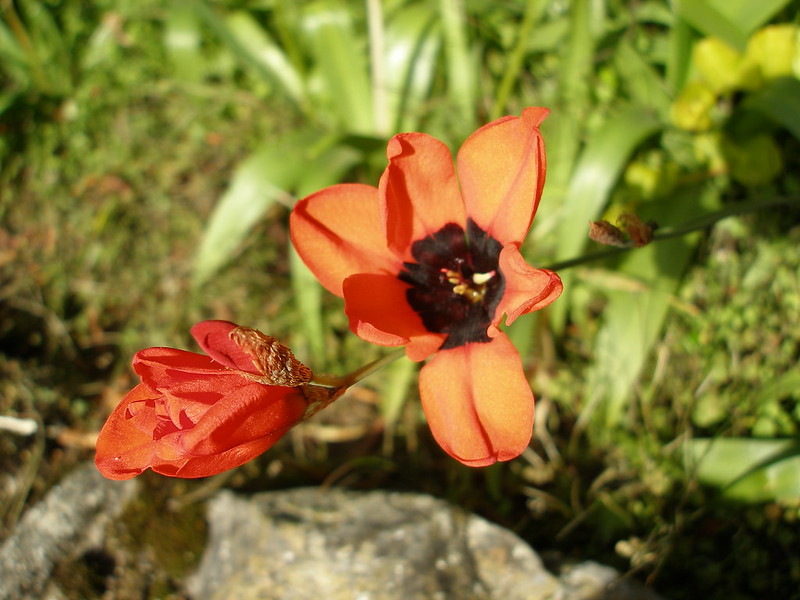Harlequin Flower Facts
- The short term of Harlequin Flower serves as the most frequently used common name for an extremely impressive variety of flora. It does possess other general names, though. These alternate monikers include such various terms as the wandflower and the sparaxis.
- Among scientific professionals, however, it’s perhaps better known by its technical designation. Luckily, that’s one that’s relatively easy for the layperson to pronounce. This holds true because the marvel of Nature and evolution holds the formal appellation of Sparaxis tricolor.
- The plant received that official epithet due to the efforts of John Gilbert Baker. The noted British botanist accomplished the first acknowledgement of the wonder as a separate and distinct species. He further achieved that scientifically noteworthy feat in the year 1877.
- Quite sadly, that endemic range appears to continue to remain extremely restricted. However, its distinctiveness led to the fabulous species becoming a highly popular import. The plant has therefore become reasonably well established in various isolated locations.
- The marvelous work of Nature also became extremely common to portions of the United States. As a result, it now grows wild in certain portions of the state of California. It also appears to be continuing to expand its range, albeit in widely scattered and isolated pockets.
- The Red List of South African Plants lists this species as Vulnerable. This listing for the magnificent Harlequin Flower occurs because of several specific factors. That fact primarily occurs because of its native range. Restricted to begin with, this now faces habitat destruction.
Related Species
Harlequin Flower Physical Description
The attention-grabbing Harlequin Flower quickly dazzles most of those individuals fortunate enough to encounter it. It does so, however, regardless of any imposing physical characteristics. That’s due to the fact that this intriguing flora represents a smaller member of its group.
Nature, though, places no particular importance on simple size in its myriad creations. This particularly gorgeous product of evolution attains an average height reaching between 12 – 14 in (30.5 – 35.5 cm). The lovely blooms further develop atop relatively long, thin stems.
Its foliage also garners its own fair share of attention. That’s due to the fact that the lovely leaves of the remarkable plant typically display as a comparatively pale green in color. This part of the species also typically displays a highly tapered shape, in addition to the most unusual color.
The marvelous blooms of this amazing work of evolution themselves grow to a very respectable size. These usually attain an average size measuring approximately 3.25 in (8 cm) in diameter. A surprising, strongly funnel-shaped tube also sits at the center of each delicate bloom.
Yet the appealing color patterns of the Harlequin Flower present perhaps the greatest surprise to the eye. The outer edges of each petal display a bright orange or red. The inner portion, meanwhile, presents a bright yellow. A thin black border also separates the two sections of the petals.
- Kingdom: Plantae
- Phylum: Tracheophyta
- Class: Magnoliopsida
- Order: Liliales
- Family: Iridaceae
- Genus: Sparaxis
- Species: Sparaxis tricolor
Harlequin Flower Distribution, Habitat, and Ecology
Regrettably, the Harlequin Flower evolved as native to an extremely limited range of natural habitation. That, however, is a region of the world already renowned for its abundance of remarkable flora and fauna. It appears natively only in portions of southern Africa.
For the moment, evidence further indicates that the species never appeared naturally in any greater range. The reason for this continues to elude researchers for the moment. Currently, even within this terribly restricted range, it’s only found in scattered population concentrations.
As sometimes happens in Nature, the very nature of the marvelous plant works against it in some ways. That holds true due to its specific environmental requirements. The surprising fact remains that this beautiful plant also evolved to thrive in a very specific and uncommon type of habitat.
The botanical wonder therefore requires these special circumstances to prosper. These requirements include such factors as relatively warm conditions, in addition to very well-drained soil placed in sunny areas. That naturally limits its potential to spread outside of its present range.
In portions of the state of California, the Harlequin Flower managed to escape cultivation. This action occurred after its being imported as a frequently used garden plant. Due to this escape, scattered small populations of the plant now exist across various portions of the region.
Species Sharing Its Range
Check out our other articles on 7 Magnificent Wild Canines, Green Dragontail, Lake Natron, Vietnamese Mossy Frog, Green Sea Turtle, Australian Ghost Shark, Clouded Leopard, Weka

